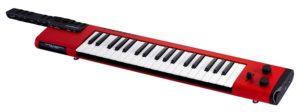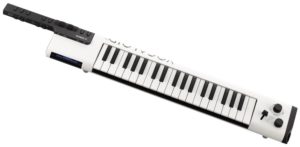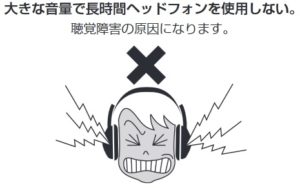[I had a chance to think about yesterday’s SHS-500 Sonogenic announcement. Please think of this blog post as a pre-review.]
The Yamaha SHS-500 Sonogenic is a fun instrument for people without musical training. It could very well be fun for musical amateurs and pros, too!
The SHS-500 is an interesting alternative to arranger keyboards. With an arranger keyboard, one typically uses the left hand to play chords which drive auto accompaniment. The right hand carries the melody or some kind of sweetener. Even though some pros like to denigrate arranger keyboards, truly entertaining and creative use of an arranger keyboard takes serious skill as well as knowledge of chords and harmony. [Click images to enlarge.]
Let’s face it — most ordinary folks just want to play along with popular hits. [A “popular hit” depends upon your musical era!] With auto accompaniment, you need to play the harmony either by ear or following a lead sheet. Sure, you can also play along with an MP3 or WAV file, but neither the MP3 or WAV file is analyzed for chords, nor are derived chords displayed such that you can follow along as you play.
The SHS-500 has a different approach. [I’m going to refer to it as “SHS” for brevity and easy of typing.] The SHS communicates with Yamaha’s Chord Tracker app. Chord Tracker not only plays digital audio files, Chord Tracker analyzes the song within and displays its chords. With an SHS attached to your smart device, Chord Tracker sends the chord information to the SHS where it is displayed. Even cooler, the chord information determines the (musically allowable) scale tones to be generated by the SHS.
Bottom line: An untrained user can plays along with their favorite hit. They can flog away at the keyboard and the SHS figures out the correct notes to “play” given the current chord in the song. Cool! You can also record audio data to Chord Tracker.
This is the SHS “Jam mode.” There are five jam modes: 1 Finger, Melody A, Melody B, Melody C, Backing.
Three buttons on the neck control song playback in the app: [Fast Reverse], [Play/pause] and [Fast Forward]. Pitch bend and modulation wheels are also on the neck.
One can connect the SHS to Chord Tracker through USB or wireless Bluetooth. I suspect that Bluetooth will be the dominant option as who wants to dance and play while tangled up in a cable? Same for battery power over AC adapter.
Yamaha priced this product right. Although the MSRP is $499, the street price will be $300 USD. Yamaha initially priced the Reface series models too high and eventually the price was lowered depending upon depend for specific models. (You can tell which models move well and which don’t.) Reface pricing settled around $300. The SHS is targeted for the youth market and a high price would be a turn-off or out of the financial reach of most teens.
Yamaha can sell at a lower cost because they repurposed hardware from the VKB-100 Vocaloid keytar. The VKB-100 is sold mainly to the Japanese market since the player “sings” in Japanese. Yamaha made a smart decision here by repurposing the VKB-100 for the world-wide youth market. Essentially, it’s the SHS’s software which is brand new.
I’m sure there will be people who scoff at the SHS-500. I, for one, love any product or instrument that encourages the love of music. Music education in the USA has taken a big hit due to testing mania and back-to-basics. I’d really like to see more young people take up musical instruments and the SHS-500 Sonogenic might be the ticket. [Plus, I’d really like to have one. :-)]
SHS-500 effect types
Dist.1 Distortion
Dist.2 Distortion
DSP Chrs Chorus
Flanger Flanger
Phaser Phaser
Tremolo Tremolo
RotarySp Rotary Speaker
LPF Low Pass Filter (cutoff adjustable)
HPF High Pass Filter (cutoff adjustable)
There is also a filter function with adjustable cutoff frequency and resonance.
SHS-500 voice list
The Yamaha SHS-500 has thirty voices. Here is a table from the reference manual.
No. Voice Display MSB LSB PC1
--- ----------------- -------- --- --- ---
001 Saw Lead 1 SawLead1 104 20 91 [Gemini]
002 Saw Lead 2 SawLead2 0 104 82 [RS SawLead1]
003 Quack Lead QuackLd 0 112 85 [Portatone]
004 Bright Decay BriteDcy 104 21 85
005 Square Lead SquareLd 0 112 81 [Square Lead]
006 Under Heim UndrHeim 104 51 88
007 Analogon Analogon 104 52 82
008 Synth Brass SynBrass 0 113 64 [Ober Brass]
009 Electric Piano E.Piano 104 28 5
010 DX Electric Piano DXPiano 0 112 6 [DX Modern]
011 Electric Guitar E.Guitar 104 3 31
012 Jazz Guitar J.Guitar 104 0 27
013 Acoustic Guitar A.Guitar 0 117 26 [Steel Guitar]
014 Electric Bass E.Bass 104 6 34
015 Slap Bass SlapBass 0 112 37 [Slap Bass]
016 Synth Bass SynBass 0 112 39 [Resonance Bass]
017 DX Bass DXBass 0 118 40 [DX100 Bass]
018 Piano Piano 0 112 2 [Bright Piano]
019 Piano & Strings Pno&Strs 104 39 1
020 Piano & Pad Pno&Pad 104 40 1
021 Air Choir AirChoir 0 112 55 [Air Choir]
022 Strings Strings 0 116 49 [Bow Strings]
023 Brass Brass 0 117 63 [Pop Brass]
024 Trumpet Trumpet 0 115 57 [Trumpet Sweet!]
025 Flute Flute 0 115 74 [Flute Sweet!]
026 Alto Sax AltoSax 104 2 66
027 Tenor Sax TenorSax 104 3 67
028 Harmonica Harmnica 0 112 23 [Harmonica Sweet!]
029 House Kit HouseKit 127 0 65
030 Power Kit PowerKit 127 0 88 [Power Kit 1]
Voices number 029 and 030 are drum kits. Bank select and program change values which match PSR (Tyros, Genos) are noted.
Copyright © 2019 Paul J. Drongowski



